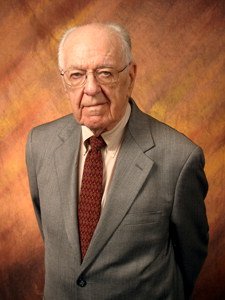In memoriam: Neal R. Amundson

Neal Amundson was namesake of University of Minnesota’s Amundson Hall
Neal R. Amundson, former University of Minnesota professor and namesake of the University’s Amundson Hall, died February 16, 2011, in Houston at age 95. Amundson, who served as head of the University of Minnesota’s chemical engineering department for 25 years, was a transformational figure in chemical engineering considered by many as the “father of modern chemical engineering.”
Amundson was born on January 10, 1916, in St. Paul, Minnesota. After graduating from St. Paul’s Central High School, he went on to earn a B.S. and M.S. in chemical engineering from the University of Minnesota in 1937 and 1941, respectively; and a Ph.D. in mathematics from the University of Minnesota in 1945.
After only a few years teaching at the University of Minnesota, he was appointed head of the Department of Chemical Engineering in 1949 at a relatively young age of 33 and remained in this position for the next 25 years, until 1974. During his 25 years as department head, Amundson helped the department to achieve a high national ranking among chemical engineering departments, which it still retains.
Among his early faculty hires were individuals with background in microbiology, mathematics and chemistry, who themselves made enormous contributions to the field. He was the earliest proponent of interdisciplinary research, so common in universities today.
Amundson’s own research was also highly regarded. He authored more than 200 articles in journals and five books. His research led to many advances in the design and operation of chemical processes. Starting in the 1950s, he repeatedly demonstrated the advantages of applying mathematical modeling and advanced solution techniques to predicting the behavior of complex chemical processes and systems. He pioneered the application of advanced mathematical techniques to understand the behavior of chemical processes, including chemical reactors, separation systems, polymerization, coal combustion and atmospheric science. His research led to a deeper understanding of such systems, and contributed to their better and safer design and operation. This approach is now widely followed all over the world in education, research and practice.
The University of Minnesota recognized the magnitude of his contributions to research and the University in 1979 when the building housing the chemical engineering department was named Amundson Hall.
Amundson joined the Department of Chemical Engineering at the University of Houston in 1977, and led it to prominence as well. He most recently served as the Cullen Professor Emeritus of Chemical and Biomolecular Engineering and Professor of Mathematics at the University of Houston.
Amundson has received many prestigious honors including being elected as a member of the prestigious National Academy of Engineering (1970), National Academy of Sciences (1992) and the American Academy of Arts and Sciences (1992).
Among his many accomplishments, he was often most proud of his students. He guided the research of 52 Ph.D. students, many who went on to be department chairs and deans at universities, CEOs of major companies and members of the National Academy.
Amundson is survived by his wife of 69 years Shirley Dimond, his children Gregg, Beth and Erik, six grandchildren and four great-grandchildren. Amundson’s hobbies included raising orchids, and at one time he held one of the largest private collections in the country. The family requests that in lieu of sending flowers, contributions be made to funds in his memory at either the University of Minnesota or the University of Houston.
